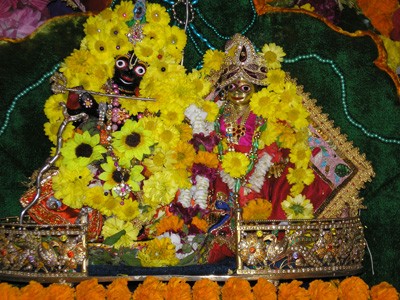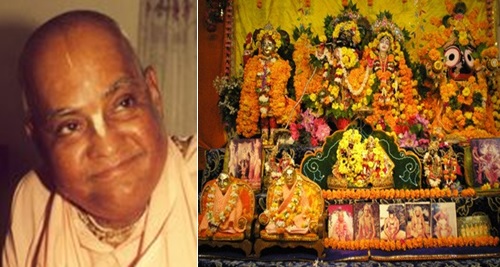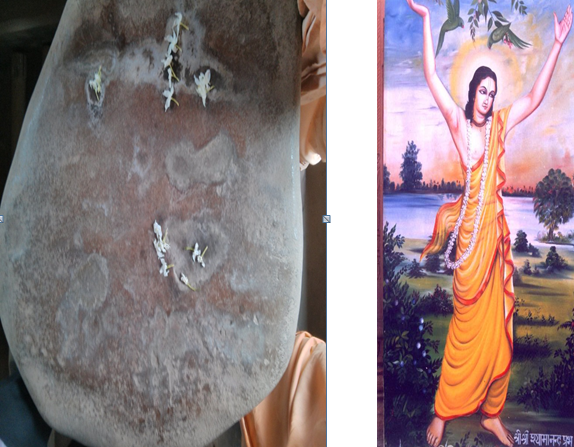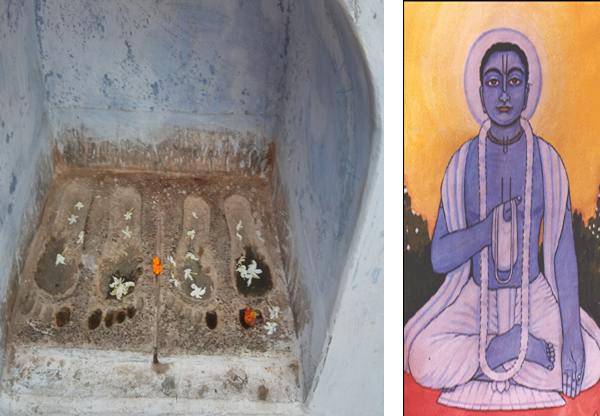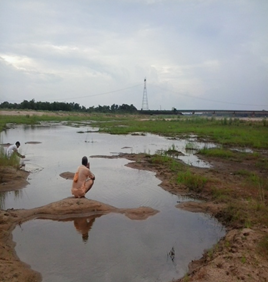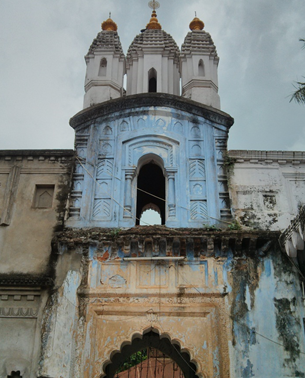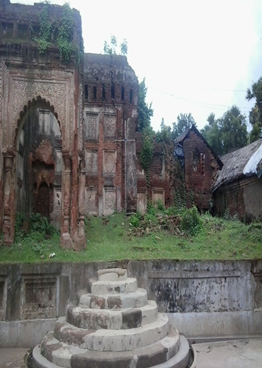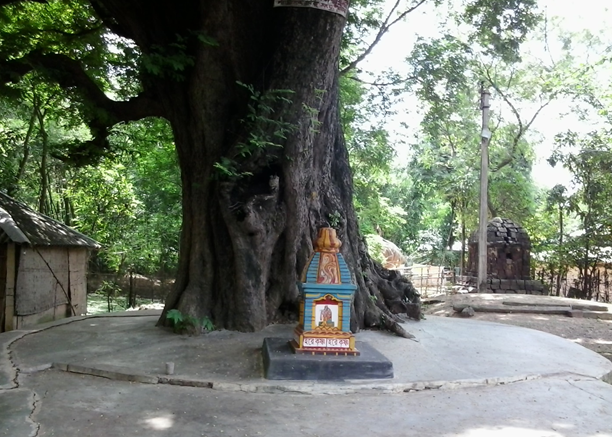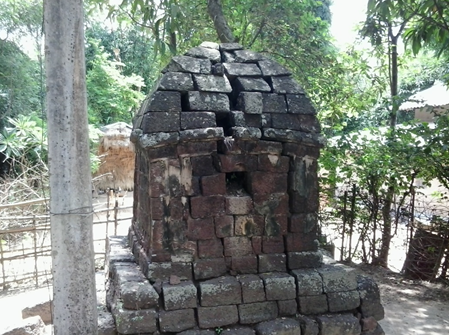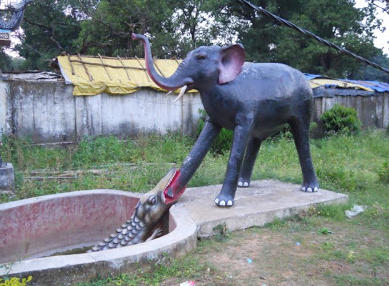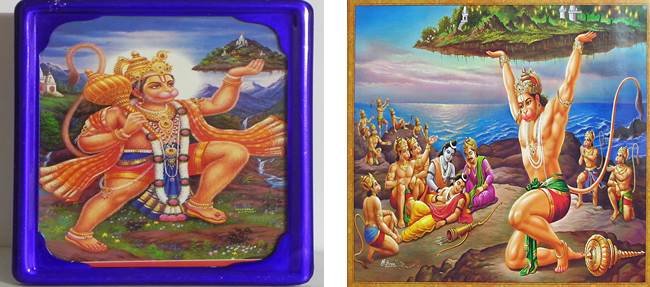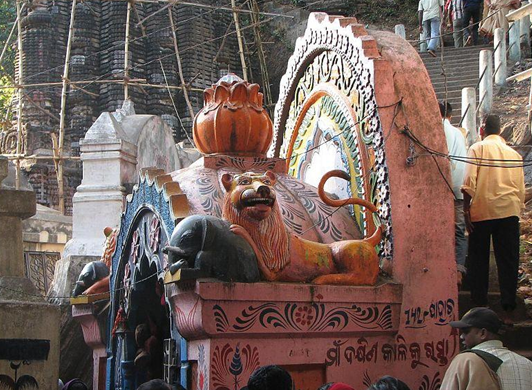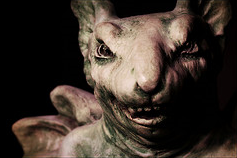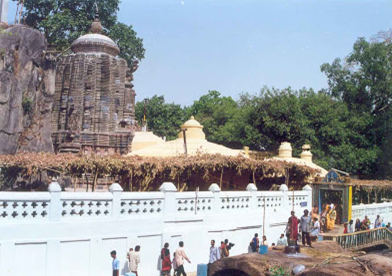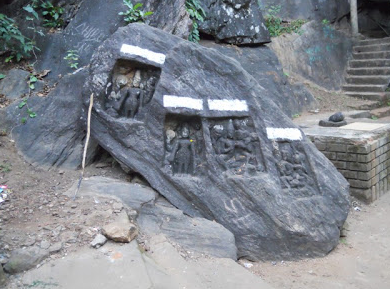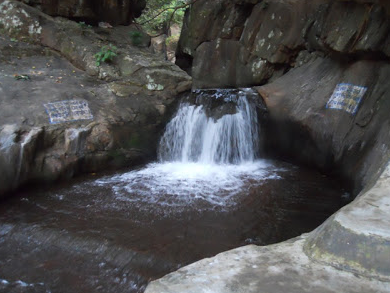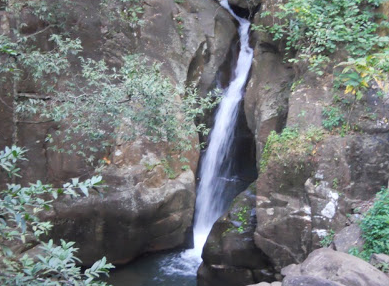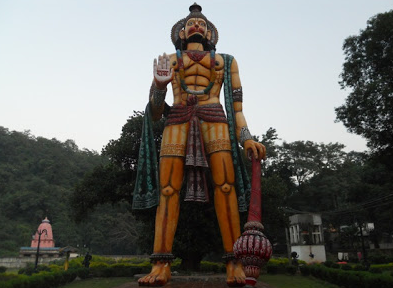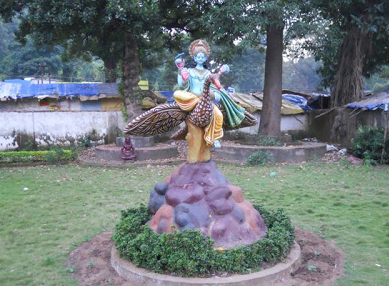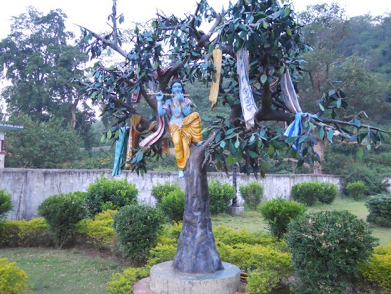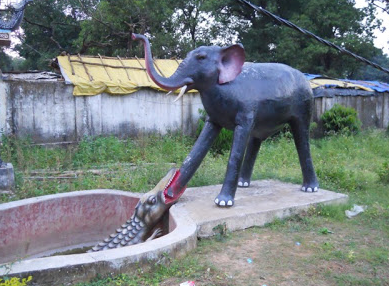Gadeigiri : Sri Sri Radha Gopalji Temple
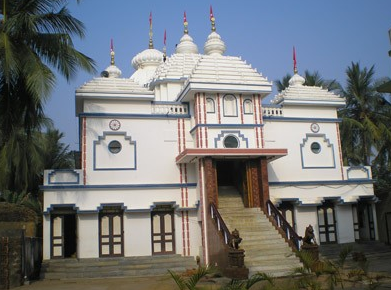
The rurally situated Sri Sri Radha Gopalji temple is in Gadeigiri, Jagatsinghpur district, Orissa. It is several hours out of Bhubaneswar (by car or bus).
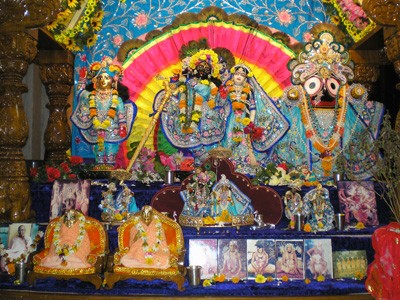
On the centrally situated main altar are Sri Gaurahari, Sri Sri Radha Gopal, Sri Nrsimhadeva (Salagram Sila/yellow face), Sri Jagannatha (Dadhi Baman), (middle fltr.:) Sri Sri Radha Madanmohan, Sri Sri Radha Gopalji, Sri Sri Radha Sundargopal and (bottom fltr.:) in murtiform H.D.G. Gour Govinda Swami Srila Gurudeva and H.D.G. A.C. Bhaktivedanta Swami Srila Prabhupada and furthermore in photoform Sri Guruparampara and the six Goswami’s of Vrindavan.
SRI SRI RADHA GOPALJI
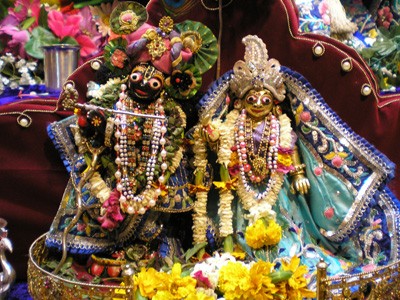
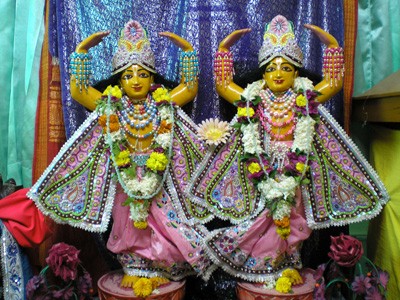
At the back of temple, (on the leftside) there is the altar with Sri Nrsimhadeva and Sri Prahlad (not shown) and with the saviours of the most fallen Sri Gauranga (a.k.a Sri Krishna Caitanya Mahaprabhu) (on our right) and his eternal brother Sri Nityananda (on our left). Gopalji deity of GADEIGIRI and H.H Gaura Govinda swami Maharaj
Chapter One: Early Years
The village of Gadeigiri is situated in the Jagatsinghpur district of east central Orissa. It is a quiet place much like other small villages in India, consisting mostly of mud huts with thatched roofs. The residents take their daily bath in the local pond, keep cows, and cook over cow dung fires in the same way their ancestors have done for thousands of years. The main source of livelihood is rice cultivation and the selling of brass utensils. In front of almost every house one will find a shrine for the sacred tulasi plant, and it is common to hear the sound of the maha-mantra: “Hare Krsna Hare Krsna Krsna Krsna Hare Hare Hare Rama Hare Rama Rama Rama Hare Hare” being sung. The residents of Gadeigiri are very devoted to Gopal. The long-standing tradition in the village is that the first fruit or flower that appears in any garden must be offered to the Gopal deity, and it is understood that by doing those trees and shrubs will thus give their fruits and flowers abundantly.
The sacred Alaka river is of great importance to the area. The businessmen of ancient Kalinga, modern day Orissa, would travel via the Alaka to the Mahanadi River, and then via the Bay of Bengal to the southeast Asian islands of Bali, Sumatra, Java and Borneo. By this trading they were able to earn substantial wealth and gradually establish the culture of Orissa in those foreign lands. To this day there are people living in Bali who are addressed as “kling”, a contracted form of the word “Kalinga”. This ancient trade connection with Bali can still be seen in various place names of the district, such as Balikuda and Balisahi, and in the annual celebration of the “Bali-yatra” festival, which means, “travelling to Bali”.
With the wealth earned through this lucrative trading, the Kalinga merchants built numerous temples for different deities on both sides of the Alaka. Later, devotees and sadhus also established numerous temples and mathas in the Alaka basin. The temple of Sri Radha Gopalji is one of them.
The village Gadeigiri is named after its founder Gadai Giri who migrated from the district of Midnapur1 in the seventeenth century. He was a businessman who regularly came to the area to sell utensils and bell metal items. Every year Gadai Giri would come during the rainy season, stay four or five months, and then return to Midnapur. Gadai Giri was a gentle and saintly person. He would rise early each morning and perform kirtan. Then after taking some flat rice and water he would go out selling brass utensils door to door. When evening arrived he would spend the night in some village and join with the local people in their daily custom of singing kirtan and reciting Srimad Bhagavatam. He soon became well known as a good kirtan singer and devotee and he received frequent invitations to take part in the different sankirtan festivals celebrated for the pleasure of the various local deities of Baladev Jiu, Brindaban Bihari Jiu‚ Radha Madan Mohan Jiu, and Dadhi Baman Jiu.
The local zamindar, feudal landlord, lived in Harispur, six kilometers from present-day Gadeigiri. Appreciating Gadai Giri’s saintly qualities, the zamindar offered to give him some nearby land. Shortly thereafter Gadai Giri met a naga-sannyasi, a naked mendicant, who was very pleased with Gadai Giri’s gentle behavior and high character. One day, Gadai Giri and the sannyasi were walking together in the forest when suddenly they heard the sweet voices of several different kinds of birds as well as the sounds of a flute, ankle bells, and a conch shell. The naga-sadhu told him, “Where such auspicious sounds are heard, Krishna Himself is present. Wherever Krishna is present His consort Lakshmi, the Goddess of fortune, is also present. This is a sacred place, a place of glory. You should build a house here for your residence and engage yourself fully in the service of the Lord. Here, whatever you desire will be immediately fulfilled.” Presenting all these things before the zamindar, Gadai Giri received from him a large segment of land, including area for cultivation. He cleared a small section of the jungle indicated by the naga-sadhu and built a house and a small temple wherein he established a deity of Dadhi Baman. When Lord Jagannath is worshiped without His brother Baladev and sister Subhadra He is known as Patita Pavan or Dadhi Baman. Gadai Giri left his brass business and simply engaged himself in bhajana and kirtan. Many wandering sadhus and sannyasis came to join with Gadai Giri’s kirtan. Gradually other people came to stay permanently, and a village developed in that place in Gadai Giri’s name.
Gadai Giri had only one son, who was named Gopal Giri. Gopal Giri was influenced by the devotional qualities of his father and was very devoted to Lord Jagannath. Every year he would go to Puri to see the Ratha-yatra festival. He was also very attached to perform sankirtan, and was expert in many different styles of kirtan.
Gopal Giri had a desire to worship a deity of Gopal. Unable to find such a deity, he decided to go to Puri, thinking that if he would render service to Lord Jagannath there, then somehow Gopal would come to him. Arriving in Puri, he stayed in the area known as Kundei Benta Sahi, near Grand road. As he was very scholarly, he easily obtained service in the office of the king, where he became the poddar, or cashier for the temple of Lord Jagannath. Gopal Giri led a very regulated life. While staying in Puri he would daily go to see Lord Jagannath. While at the temple he would sit on the bais pahaca, the twenty-two steps inside the compound leading up to the main darsana area, and there he would read Srimad Bhagavatam. In the evening he would take prasadam and go home. Every Sunday he would go to the Satalahari Math, a temple near the ocean, where he would sit and read Srimad Bhagavatam and chant harinam. He was very attached to Srimad Bhagavatam.
Gopal Giri had long cherished the desire to worship a deity of Gopal. During the Ratha-yatra festivals in Puri he would approach devotees and sadhus coming from Vrindavan and ask them to bring him a deity of Gopal. They would readily agree, “Yes, yes. Next time I will bring a Gopal deity for you.” But no one ever brought a deity.
At the same time, in Vrindavan there was one renounced devotee who was worshiping a deity of Gopal. One night theGopal deity appeared and spoke in the sannyasi’s dream. Srila Gour Govinda Swami tells this story:
Gopal Giri was serving in Puri as a government cashier. He was always thinking in his mind, “If I can get a Gopal deity I’ll offer worship to Him.” But he thought, “How can I go to Vrindavan?” He had a strong desire to get a deity.
At that time this deity of Gopal was in Vrindavan with a sannyasi vaisnava, a renunciate. He was doing madhukari, begging, and he was keeping that deity in his jhola,(a cloth tied as a bag). During the day, he would go out and do madhukari, then in the evening he would cook whatever he had begged and offer it to Gopal. In this way he was leading his life.
One night this Gopal deity told the vaisnava, “You take me to Gopal Giri, the son of Gadai Giri.” He wants to offer Me worship. I want to go there. Take me there. But the vaisnava thought that it was only a dream. He did not take it seriously. After a few days Gopal came again in a dream and beat him with a cane on his legs. It was such a severe beating that his legs were bleeding. The sannyasi vaisnava woke up and begged apology, “Please forgive me for my offense. I did not take Your order seriously. But You have beaten me so severely, how can I go there with such wounds on my legs?” Gopal said, “When Gopal Giri touches you it will be healed, otherwise you cannot be cured. You go there at once, don’t make any delay”.
So he started walking. At that time there was no communication system, no train or bus. The only way was by walking. It took him two and half months to reach Puri. At that time, Gopal Giri was staying in a rented house at Kundhei Benta Sahi in Puri. The vaisnava reached Puri in the evening and stayed near the Jagannath temple. On the next early morning he inquired, “Who is Gopal Giri? I want to meet him.” Many people knew Gopal Giri; he was famous as the cashier of the Jagannath temple. So he quickly found Gopal Giri at his rented house.
Gopal Giri had just finished his bath and was putting on tilak. The vaisnava arrived and offered his obeisances to Gopal Giri. He then took the deity from his bag and presented Him to Gopal Giri. Gopal Giri was amazed, “What is this? Who are you, and where has this deity come from?”
The vaisnava replied, “You wanted Gopal to worship. So Gopal has come from Vrindavan. I was in Vrindavan carrying this Gopal. He told me to hand Him over to you, and He beat me. He showed Gopal Giri his legs and said, “If you touch it, it will be cured, otherwise it will not be cured.” So Gopal Giri immediately touched him and the injury was gone.
Gopal Giri was very happy that Gopal had fulfilled his desire. He couldn’t go to Vrindavan, but Gopal had come to him. Gopal Giri went to the market and purchased rice, dal, and vegetables. He prepared prasada and gave some to the vaisnava. Then he went to the king and offered his resignation, saying, “I don’t want to serve any more.” When he returned to his room he opened his bag and told that vaisnava, “You can take as much money as you want”.
The vaisnava said, “No, I don’t want any money. I only want to do service for Gopal. Wherever Gopal goes, I will go. I want to go and serve Him. I am not the one who sell Gopal. I am a servant. I won’t take any money.”
Later on, Gopal Giri again went to see the king. The king asked him, “Why did you resign?”
“I have a temple in my village and I had a desire to get a deity of Gopal to worship.”
The king was very pleased and said, “All right, your desire is very noble. I have no objection. But sometimes you must come to Puri with your kirtan party and chant in Jagannath’s temple”.
Gopal Giri also had a deity made of Radha and installed Her. Their temple was a mud hut. He made all arrangements for Gopal, providing agricultural property so that in the future there would not be any difficulty for Gopal’s maintenance. Gopal Giri was a wealthy person. His family had landed property and they were famous for kirtan. Every day kirtan was going on. At last that land has come to me. Now we are taking care, constructing a nice temple for Gopal.
The king gave Gopal Giri some extra months’ salary and allowed him to go. Gopal Giri then sent a message to Gadeigiri for a kirtan group to come to Puri to accompany Gopal to His new home. When the Gajapati king heard the kirtan of the Gadeigiri villagers he became very pleased. It is written in the Madala-Panji, the history book of the temple of Lord Jagannath, that whenever the kirtan party from Gadeigiri comes they should be allowed to perform kirtan in the temple.
Gopal Giri installed the Gopal deity in Gadeigiri and requested the renunciate from Vrindavan to perform Gopal’s daily worship. After serving Gopal for twenty years, the renunciate departed this world and was given samadhi, ritual burial, near Gopal’s temple. After this, Gopal Giri engaged other renounced vaisnavas for the daily worship of Gopal.
After Gopal Giri departed at the age of 85, responsibility for Gopal’s service passed on to his son, Dinabandhu Giri.
GJ 2: Kirtan Gurus
Chapter Two: Kirtan Gurus
In the early seventeenth century, Shyamananda and Rasikananda Prabhus had preached all over Orissa, converting thousands into followers of Sri Chaitanya Mahaprabhu. They had a unique style of kirtan, quite distinct from the styles practiced by Srinivas Acharya and Narottam Das Thakur in Bengal and north-eastern India, and this style became very popular in Orissa, becoming known as Odisi-kirtan. Dinabandhu Giri, like his father and grandfather before him, was expert in Odisi-kirtan. He performed kirtan all over Gadeigiri and the surrounding villages and was highly appreciated by the villagers. The Giri family was often invited to teach kirtan, thus they became known as kirtan gurus, instructing others in the performance of kirtan.
Dinabandhu Giri also lived to be 85, and after his departure Gopal’s care was handed on to his son Abhiram Giri. Although Dinabandhu Giri was very expert in sankirtan, his son Abhiram was not. One day as the father and son were doing kirtan in a nearby village, some people criticized Abhiram Giri saying, “How is it that the son of a kirtan guru cannot do kirtan?” Abhiram Giri felt very sad. He decided that when he returned to Gadeigiri he would pray to the Gopal deity for the ability to do kirtan. According to the Giri family history, just before Abhiram arrived at Gopal’s temple he saw mother Durga-devi, who is known as Jagulai, the protector of the village, coming to have darsana of Gopal. Abhiram offered obeisances to Durga-devi, who is Vaishnavi-devi, a great devotee of Krishna. Jagulai-devi could understand Abhiram Giri’s desire and she gave him the benediction that whenever he sang, everyone would appreciate it. Then she asked him to let her see Gopal.
The temple of Jagulai Durga is situated at the entrance way to the village of Gadeigiri. She is the presiding deity of the neighboring village of Nagpur. It is considered that she acts as a guard for Gopal’s territory and that she regularly comes to have darsana of Gopal. Many local people have claimed to have seen her coming, carrying a burning masala, a type of torch common in rural areas. The local residents say that she comes every night for darsana of Gopal at midnight.
Abhiram Giri served Gopal until he passed away at the ripe age of 90, and Gopal’s service then passed on to his son Bhagavat Charan Giri. From the time of Gopal Giri the family had engaged only sannyasis to perform the daily worship of Gopal. This tradition stopped during the life of Bhagavat Charan Giri. In one conversation Srila Gour Govinda Swami explained why?
One vaisnava sannyasi came to Gadeigiri and started doing service for Gopal. He thought to himself, “Oh, very nice deity, and He is staying in a thatched house, no security is there. Once he thought, “I will steal these deities.” At night he stole the deities and took them away. In a dream Gopal called my ancestor and told him, “This person is stealing Me away! Come immediately and rescue Me.” The sannyasi had only gone a short distance when a very poisonous snake came and bit him, killing him. Finding Gopal lying on the ground, my ancestor picked Him up and took Him back to the temple.
After this incident, fearful that someone else would attempt to steal Gopal, Bhagavat Charan Giri engaged only hired brahmins for Gopal’s worship. As a further precaution, he would not engage any brahmin for very long, but would regularly change them.
Bhagavat Charan Giri had two sons, Bhikari Giri and Lakshman Giri, and he passed away at the age of 82. Bhikari means a beggar or sannyasi. This was an appropriate name for the oldest son of Bhagavat Charan Giri, for Bhikari Giri left home and took sannyasa at the age of 30. Wanting to dedicate himself to his beloved Lord Krishna, Bhikari Giri spent the rest of his life doing bhajana in Vrindavan, where he stayed until he passed away at the age of 75.
Bhikari Giri had one son, Govinda Giri, who also became famous as an expert singer of kirtan. His descendent Ghanashyam Giri relates:
Whenever Govinda Giri would start singing kirtan, people would not be able to stay away. Even if they were sleeping they would give up their sleep to come and hear his singing. Wherever Govinda Giri would go he would take his son Bauri Giri with him. Bauri Giri was deeply influenced by his father from a very early age. From his childhood he was very devoted to Gopal.
Govinda Giri passed away in 1933 at the age of 88. Before he departed he entrusted Gopal’s service to his son Bauri.
GJ 3: Bauri Giri
Chapter Three : Bauri Giri
Bauri Giri is still remembered today in the Gadeigiri area as being a paramahamsa and a premi-bhakta, a very advanced devotee. If anyone were suffering from a disease in the village they would approach Bauri Giri for help. Bauri Giri would simply speak the name of Gopal, touch the body of the patient and that person would be cured of his ailment.
Bauri Giri was always doing kirtan for Gopal’s pleasure. He became famous for his kirtans, and his reputation spread far beyond Gadeigiri. Many high government officers and other prestigious persons would come to hear, including Bala Mukunda Kanungo, the famous deputy magistrate2.
The nearby village of Balisahi is also famous for kirtan. Seeing the popularity of Bauri Giri, some persons in Balisahi became a little envious. They brought in a kirtan guru from another area and began studying various types of kirtan. Then they challenged Bauri Giri to a kirtan competition, a common event in those times. The venue was the Jagulai Durga temple. Many persons, including Bala Mukunda Kanungo, came to see.
Bala Mukunda Kanungo first spoke, “We are always hearing kirtan from Bauri Giri, so he should sing last. But we have not heard from this Balisahi guru. We request that he should begin his kirtan first. It is morning now, so he should start his kirtan with a description of morning in Vrindavan, the atmosphere there, and the pastimes Krishna performs at this time of day.” The guru began his kirtan, but he could not properly sing the morning pastimes of Krishna. In the morning, Krishna and His elder brother Balaram go to the forest with Their cowherd boyfriends and the cows. But the guru sang of Krishna’s afternoon pastimes when They are all returning home. Because he was unable to properly sing about the correct time and atmosphere, the audience did not appreciate his kirtan. Everyone was then waiting to see what Bauri Giri would sing.
Bala Mukunda Kanungo then spoke to Bauri Giri, “The time is now twelve o’clock noon, so you should sing a description of the pastimes that go on in Vrindavan at this time of day.”
Bauri Giri started singing very nicely, describing how Krishna and Balaram were enjoying a feast in the forest with all of the cowherd boys. Everyone there appreciated it and clapped loudly. At the end all support went to Bauri Giri. Everyone said that he was the real guru of kirtan.
Bauri Giri would never eat anything that was not offered to Gopal. He was also very particular that Gopal’s servitors should cook in a devotional way. At the time of cooking he would often tell them, “Be attentive in your service.”
On one occasion Bauri Giri was leaving for a trip. Before going he gave the brahmin priest a large quantity of bananas to offer to Gopal. When he returned from his journey he came before Gopal and stood silently for several minutes. Then he turned to the brahmin and asked, “Did you offer the bananas?” “Yes I did,” the brahmin assured him. Then a little more sternly Bauri Giri asked, “When did you offer them?” Bauri Giri could see that Gopal was suffering from a cold because the brahmin had offered all the bananas at one time. He then offered Gopal some Ayurvedic medicine to “heal” His ailment.
Bauri Giri, left this world on Saturday 28 January 1939. Generally he was in fine health, but the previous day he became slightly ill with a low fever and laid down to take rest. After a short time he asked, “What day is tomorrow?” His eldest son Gopinath Giri replied, “Tomorrow is Chandrabhag-bauda.” Chandrabhag-bauda is an auspicious holy day for the pious people of Orissa. It is also the appearance day of Srila Adwaita Acharya, the associate of Sri Chaitanya Mahaprabhu and incarnation of Maha Vishnu.
Bauri Giri replied, “So I will leave my body tomorrow.”
Gopinath Giri was stunned. “Father, what are you saying?” Bauri Giri said, “I don’t want to stay anymore. I want to leave this world. Tomorrow morning on the day of Chandrabhag-Bauda, I will leave my body. Today I want to see all of my relatives and friends, please call them.
“This message was spread to all the neighboring villages and everyone assembled there. He said, “Tomorrow I will leave my body. I don’t want to live in this world any more. I don’t like it.”
All the villagers, Bauri Giri’s friends and relatives then started nama-sankirtan. The chanting continued all night long. When it became dawn, Bauri Giri asked, “What is the time now? Please take me outside, bathe me and make a bed for me.”
Everything was arranged as he asked. After his bath he took darsana of Surya, the sungod, and then he took darsana of Gopal. Then he told his eldest son, “Please hold me.” And with that he left his body. He was sixty-nine years old.
Bauri Giri left behind him three sons, Gopinath Giri, Jagannath Giri, and Dinabandhu Giri, and two daughters, Pata-devi and Hade-devi. The eldest son Gopinath Giri was entrusted with Gopal’s service. Both Gopinath and Jagannath Giri were expert in kirtan and were always singing bhajanas for Gopal.
Gopinath Giri’s son Ghanashyam Giri recalls:
In 1967 at the age of 72, my father Gopinath Giri called his family and friends and told us, “I will leave this world on the upcoming agni-utsava day.” [Friday 24 February 1967, which is also the appearance day of Srila Narottam Das Thakur]
We stayed with him and in theevening, he left his body during harinam-sankirtan. Eighteen years later in 1985 at the age of 85, Jagannath Giri also left his body on the same day of agni-utsava in the month of magh. [Tuesday 5 February 1985] Govinda Giri had also left his body on the agni-utsava in the month of magh. Most of our ancestors left their bodies during the month of magh.
Before leaving, Gopinath Giri entrusted the service of Gopal to his eldest son Ghanashyam Giri.
GJ 4: Braja-Bandhu Manik
Chapter Four – Braja-Bndhu Manik
Bauri Giri’s daughter Pata-devi was very devoted to Gopal. From her early childhood she would come to see Gopal every day. Every morning she would sweep Gopal’s temple, make garlands, and cook for Him. Pata-devi married Ishwara Manik from the nearby village of Jagannathpur. Like the Giri family, Iswara Manik was also in the business of selling bell metal. Ishwara and Pata had two sons, named Braja-Bandhu and Kripa-sindhu, and one daughter named Swadhuri Devi. Their eldest son, Braja-Bandhu, born on 2 September 1929, was later to be known as Srila Gour Govinda Swami Maharaja. Being married did not detract from Pata-devi’s devotion to Gopal. Although living 14 kilometers away in Jagannathpur, she always managed to come during festival times to serve Gopal. Pata-devi was always quiet and absorbed in serving her husband and children — every Saturday she would fast as an offering for their well-being. Each morning she would worship Lord Jagannath and recite from the Puranas and Bhagavad-gita. Every evening she chanted Hare Krishna and performed tulasi-parikrama with her husband and her son Braja-Bandhu. After parikrama she would recite Srimad Bhagavatam. Any beggar or sadhu that came to her house never left empty-handed.
Once a famous blind astrologer named Nityananda Khadiratna traveled from Dhenkanal and stayed two days in Gadeigiri. At that time Braja-Bandhu was a small child and he and his mother were staying at his uncle’s house in Gadeigiri. Pata-devi took her son to the astrologer, desiring to know something about his future. The astrologer said, “This boy is very intelligent and is full of devotion. He will be married and get government service. In his middle age he will give up family life and become a sadhu. He will acquire high knowledge and an important place on the map of sadhus. He will build temples. He will make Gopal’s place bright. Lastly the astrologer said that God Himself has sent this child from His abode to the material world for preaching His message and for the deliverance of the conditioned souls.
Pata-devi was eager that her Braja-Bandhu would become a devotee of Srimad Bhagavatam, and she became very happy seeing that by her influence her eldest son was developing such attachment. By the age of eight Braja-Bandhu had read the entire Bhagavad-gita, Srimad Bhagavatam and Sri Caitanya-caritamrta, and he could also explain their meanings. At night many villagers would come to hear his recitation of the Oriya Bhagavata, Ramayana and Mahabharata. However, young Braja-Bandhu was particularly attached to the Srimad Bhagavatam. His old friend Fakir Charan Das recounts.
Srila Gurudeva once told me that whenever as a young boy he would became naughty and not stop crying, his mother would simply put the Srimad Bhagavatam in his hands and he would stop. He was so much inclined to read the Bhagavatam that if he were reading he would forget to take his meal. The family was too poor to afford candles or a lamp for reading, so in the evening he would sit close to his mother’s cooking fire and read Srimad Bhagavatam. At night he would go to sleep clutching the Bhagavatam to his chest.
From 1942 to 1945 Braja-Bandhu stayed in Gadeigiri with his maternal uncles Gopinath and Jagannath Giri and he attended high school in nearby Balikuda. Gopinath and Jagannath Giri were both fond of performing kirtan. They would regularly go out to chant in the neighboring area, and it was not uncommon for them to travel to distant villages for chanting. Often they would perform nonstop kirtan for one or two days at a time. They were very fond of singing traditional Orissan songs of Krishna’s pastimes as well as the songs of Srila Narottam Das Thakur. Whenever possible, young Braja-Bandhu would chant with them, and by their association he became deeply attached to performing kirtan.
Although Braja-Bandhu would often engage in kirtan with his uncles, still he did not neglect his school studies. During the day Braja-Bandhu would engage in study, in the evening he would join the kirtan, then in the early morning he would come back to Gopal’s temple to render service. Young Braja-Bandhu was a quiet and serious child. He did not engage in play with the other children and he showed no interest in cinema or mundane theatre. Whatever free time he had after completing his studies he would spend doing kirtan with his uncles or in rendering various services to Gopal. Braja-Bandhu would clean Gopal’s temple, pick flowers for His worship, make garlands, and recite verses and songs for Gopal’s pleasure. He would never take any food that was not offered to Gopal. As a child he was not interested in sleep and would only rest for three or four hours a night, a habit he maintained his whole life.
Ghanashyam Giri was taking care of Gopal’s worship. Braja-Bandhu would come and together they would perform kirtan and render service to Gopal. Damodar Giri was a good singer and was expert in kirtan. He was working in Bengal, but whenever he got the opportunity he would come to Gopal to perform kirtan. These three, Ghanashyam Giri, Damodar Giri and Braja-Bandhu often sat together and performed kirtan.
In 1952, on the request of his mother, Braja-Bandhu entered household life. He first met his wife, Srimati Vasanti-devi, during their marriage ceremony. Family members recall how during the wedding ceremony while everyone was enjoying the festivities Braja-Bandhu was sitting sadly by himself quietly chanting Hare Krishna. He considered family life a material entanglement and an impediment to his service to Gopal. He never wanted to marry.
Braja-Bandhu’s father passed away in 1955, and as the eldest son he became responsible for maintaining the family. Owing to financial constraints he could not enroll formally in University courses, but he studied privately at night to attend the examinations, obtaining a B.A. degree from Utkal University with overall second highest marks on the exam. He later obtained a B.Ed. degree in a similar way and obtained government service as a schoolteacher.
During the course of the next nineteen years Braja-Bandhu and Vasanti-devi had four sons and three daughters. Despite many family responsibilities, Braja-Bandhu’s devotion to Gopal never slackened. He would rise daily at 3.30 am, chant the Hare Krishna maha-mantra, worship tulasi, and speak to his family from Bhagavad-gita. In school he took every opportunity to speak to his students about Krishna and devotional principles. Thirty years later some of those same students would become his disciples. During school breaks he would take his wife and travel to the Himalayan Mountains, visiting different tirthas and ashrams, and he would sometimes engage in philosophical debates with the mayavadis he found there.
Throughout his life he wrote daily entries in his diary. For the most part these were in the form of letters to Gopal. Each entry would begin, prabhu gopala krparu, kona si mate dinoti koti gala — “By the mercy of Prabhu Gopal, this day was spent thus…” The entries would end with a prayer to Gopal, “Please give me prema-bhakti, ecstatic love of God.”
A sample, from 1 October 1973:
On account of the Durga-puja festival, school will be closed for some time. It will be reopened on Thursday 18 October 1973. Today I saw a picture of Sri Chaitanya in Banambara’s shop. In that picture I saw Mahaprabhu clutching the feet of the prema-maya-yugala-murti, the divine loving couple.
Sri Chaitanya-dev started chanting divya-prema-nama, Krishna’s divine ecstatic names. He rejected suska-jnana, dry knowledge. He preached divya-nama-prema. He gave nama-prema to all indiscriminately. Prema-taranga, the waves of prema, spread everywhere. Wherever He was going, prema was following. Even the very hard-hearted got a touch of that prema and their hearts were changed. This is the wonderful power of prema! By seeing that picture of Sri Chaitanya-dev I got a sparsa, a touch of that prema. How can I get a picture of that Sri Chaitanya-dev? By seeing His picture I’ll get a touch of prema and from prema I’ll get wonderful inspiration and bliss. Then I can give bliss to others. Prabhu Gopal, please shower this mercy on me! Give me shelter at the prema-kutir of Sri Premanandaji! I must drown in that divya-prema and, giving prema to others, pacify the fire in their hearts! From 9 October 1973:
By the mercy of Prabhu Gopal, on the last two days our Gita recitation program was finished here in my ista-deva’s [Gopal’s] temple. Prabhu Sri Gopal, O You who are known as premananda, as prema-maya-purusa, as Vrndavana-Bihari, and as radha-kanta! By your mercy this Gita program was finished with ananda and prema. Prabhu, may Your place be joyful! May prema and ananda, love and bliss, be distributed! Make me Your servitor! Give me an opportunity to distribute that prema and ananda! Don’t cheat me! Because You are antaryami-natha, the Lord of my heart, You know my desire. And I am begging that from You! Please give me that prema and ananda! Let me get it and let me distribute it!
The 1973 entries frequently mention his desire to renounce family life. From 10 October:
Today there was a mahotsava, a festival. Prasadam was distributed and bala-gopala-lila, Your childhood pastimes, were recited. Prabhu Gopal, for a long time I have had a desire to hear songs of mana-bhanjana-lila, stories of how Krishna breaks the sulkiness of Srimati Radharani. Prema-mayi Radharani had developed abhiman, loving pride, and Krishna was experiencing intense viraha-katara, pangs of separation, because Radha would not permit Him to see Her. Therefore there was a need for mana-bhanjana. Today, by the mercy of Prabhu, it happened. Vrndavana-Bihari, Krishna, became Radha-prema-bhikari, a beggar of Radha’s love. My Gopal dressed up like a sannyasi to beg prema-dhana from Radharani.
O Prabhu Gopal, please make me a yogi, sannyasi like that! I don’t need anything, Prabhu. I am not asking You for material opulence, respect, glory or anything else. You may give those things to my younger brother Kripa-sindhu. Let him maintain Your family. Make me a samsara-vairagi-yogi, a renunciate of family life. Let me beg that prema-dhana, that wealth of love of Godhead! Let me distribute prema and ananda! Let me serve You! Please shower this mercy on me, Prabhu! Please bless me with prema-bhakti, ecstatic love for You!
Out of respect to his mother, he spent twenty-two years in household life. At the age of forty-five, on 10 April 1974, at the end of the school year, he completed his routine teaching duties and then gave a letter to Prahlad Mahanty, the headmaster of the Bunbihari High School in Kujanga:
Sir,
Respectfully I beg to state that I am leaving Kujang tomorrow on 11/4/74 (morning) to start my divya yatra for Guru Dham, Rishikesh. This is for your kind information and necessary action. Yours faithfully, Brajbandhu Manik, Assistant Master 10/4/74.
Leaving the school, he went home. He did not say anything to his family, but he packed his Bhagavad-gita, two gamchas, a pen, a pencil, and one notebook. That night, while his family was sleeping, he quietly got up at midnight and walked a half-mile away to a nearby temple known as Kakudia Math. He had decided to become a sannyasi, a wandering mendicant, entrusting the care of his family to his eldest son Vijay, aged 19.
His disciple Swayambhu Das, then known as Subhas, was attending the same high school in Kujanga. He recalls:
I heard that Gurudeva had left his family life and his position as a teacher and had gone to the Kakudia Math. The day after he left home I went to Kakudia Math to see him. When I arrived he was sitting and looking at a picture of Gopal and singing over and over again, “Gopala, Gopala, Gopala, Gopala, Gopala, Gopala, Gopala.” In the afternoon a group of teachers and students from the high school arrived to meet him. They were stunned by his sudden renunciation. They asked him, “Why have you left your job and your home?” Gurudeva then asked me to recite Manabodha-cautisa, Instructions to the Mind, a song by the Oriya vaisnava Bhakta Charan Das:
kaha-i mana are mo bola kara kalasrimukha bare dekhiba calare kete dinaku mana bandhuchu anta ki ghenijibu tora chutile ghatare khandi je khandi tora panjara kathi khauna thibe svana srgala bantire khat palanke mana sejai sou khala durgandha heba e tora dehure galeni to sangaru jeteka jana ganthire banddhinele ke kete dhanare guru gobinda nama tunde nabolu gadhe majjina nitye dhana arjilure gharaboli arjichu jete padartha ghata chutile tote bolibe bhutareg ghara gharani deha kilauthibe gheni bandhu kutumba suddha hoibere
I say to you, O mind: Obey my order! Let us go and see the beautiful black-faced one [Lord Jagannath]! For how long will you remain bound in material life? At the end of your life, what will you take with you? Piece by piece your ribs will be distributed amongst the dogs and jackals. O mind, you are now sleeping comfortably on a nice mattress, but after death your body will give off a terrible smell. How many of your friends and family have already died? How much of their wealth could they bind in a cloth to take with them? You have never uttered the names of guru and Govinda! Always deeply absorbed in thinking how to gather wealth, you are acquiring so many things like house and family! But when your life is gone, all will cry, “Ghost!” The ladies of the house will close up the doors. And only after the recommended period of purification will your relatives be considered freed from contamination.
Gurudeva was listening intently to the song. When I came to the last line he fainted and fell back unconscious against me. Seeing that his jaw was clenched tightly shut, I took a piece of bamboo and pried open his mouth. When the teachers saw him faint in this way, they became convinced that Gurudeva was no ordinary person and that he was truly qualified to leave home and take to spiritual life. The students, however, still wanted him to return. Seeing the mood amongst the students, I told them, “Now he is unconscious. We can easily take him back to his home. Go and get a motor rickshaw.” As soon as they left I carried Gurudeva away where they could not find him. Later we came back to the matha. That evening Gurudeva’s wife Srimati Vasanti-devi came. Gurudeva had her sleep inside the room while he and I slept outside on top of some coconut palm leaves. In the morning I pointed out to Gurudeva how there was an imprint on his body from the leaves. He said, “Yes, renounced life is like this.” His wife was unable to convince him to return, and he sent her back home that morning. He stayed there at Kakudia Math for five or six days, during which time he called for his younger brother Kripa-sindhu and asked him to take care of his family. Then he left Kakudia Math and walked 14 kilometers to Gadeigiri to request Gopal’s permission to take sannyasa.
Leaving his old life behind, Braja-Bandhu took on a new name, “Gour Gopal”. “Gour” for Chaitanya Mahaprabhu, who is also known as Lord Gouranga, and “Gopal” after his beloved childhood deity. Ghanashyam Giri was in Gadeigiri when Gour Gopal arrived. He recalls:
He arrived at Gopal’s temple about 2:00 p.m. Generally Gopal’s arati begins at 12:00 noon and by 2:00 p.m. the arati is finished and everyone has taken prasadam. Somehow on that day the key was lost and Gopal’s service was delayed. When Gurudeva arrived, the arati was just beginning. I think that Gopal made this arrangement so that He would be able to see His dear devotee.
After the noon arati Gour Gopal read Bhagavad-gita and Rama-carita-manasa to the devotees. When he came to the pastime of Lord Rama leaving for the forest, Gour Gopal held the cloth around his neck in the manner of a sannyasi begging alms. With a choked voice he sang the following verse where Lord Ramachandra says: “Vane gale muhin muni-jane bheti sarthaka koribi prana — If I go to the forest I will meet so many sadhus and thereby fulfill my life’s desire.”
After the discussion, Gopal’s evening arati started. Braja-Bandhu’s cousin Damodar Giri began to lead kirtan and Gour Gopal requested him to sing Dasavatara-stotra by the Oriya poet Jayadev Goswami. Following the arati, Gour Gopal requested the devotees, “You should always sing this song for Gopal and remain Krishna conscious. Otherwise your life will have no value.” Hearing that Braja-Bandhu was leaving family life, many villagers, including family members and old friends of Braja-Bandhu, came to the temple that evening. Everyone requested him to go back to his wife and family in Jagannathpur. But one old friend of Braja-Bandhu named Satyananda Kandi spoke up in his support, saying, “You should let him go. If someone has tasted nectar, how will he be satisfied with water?”
That night Gour Gopal laid down to take rest in Gopal’s temple. At the last part of the night Gour Gopal woke up one of the devotees and told him, “I have received Gopal’s order. I’ll be a sannyasi.” As he was leaving in the morning, all of his old friends and family members again came to see him. Gour Gopal told Damodar Giri to sing Tika Govinda-candra:
bolu ki na rama-namare govinda, bhaju ki na rama-nama bhaji na parile kulacandrama re, bandhineba kalayama sehi kalayama bada nidaruna
Not speaking the names of Rama and Govinda, not performing bhajan of rama-nama, if we cannot worship You, O moon of the living entities, then we will be bound up by the god of death. That binding of the god of death is very painful.
Gour Gopal then told the devotees, “I am going. I will send you a letter and you should please reply. All the devotees here are great kirtaniyas. Always do kirtan for Gopal. Take care of Gopal. Gopal is the son of Nanda Maharaja. He should not stay like this [the devotees there were worshiping Him in a humble way]. We will all cooperate together to help maintain and develop Gopal’s place.”
GJ 5: Gour Govinda Swami
Chapter Five – Gour Govinda Swami Receiving Gopal’s blessings
Gour Gopal left Gadeigiri and traveled to Cuttack, where he spent the night. The next morning he set off by train to the Himalayas where he wandered in search of a guru. In a 1989 conversation Gour Govinda Swami recounted some of those days:
I was born here in Orissa. Many vaisnavas are here. There are so many mathas of Srila Bhaktisiddhanta Saraswati Goswami here in Orissa. I know many vaisnavas. I was born in a vaisnavas family. From my childhood I have been attracted to Mahaprabhu. From an early age I was performing sankirtan and worshiping Radha Krishna deities. In my family we were reading the Bhagavatam. I was born in such an atmosphere. But I had to search out a bona fide guru. I wandered from the Himalayas to Kanya Kumari, throughout the whole of India. Although I met many vaisnavas, I was not satisfied with them.
I was a secondary school teacher. I gave up my service. I gave up my family. I had seven children. I had land and property, twenty-five years government service with a pension, but I gave up everything and left home. I searched throughout India and met many vaisnavas and many jnanis and mystic yogis. I had discussions with them. Then I told them, “Sastra, scripture, says, harer nama harer nama harer namaiva kevalam, kalau nastyeva nastyeva nastyeva gatir anyatah. Only the chanting of the holy names of Krishna is the yuga-dharma in kali-yuga, the process for this age. Why shall we do all these gymnastics, hatha-yoga, dhyana-yoga, etc.?”
At last they told me, “Get out of here.” I said, “All right. Thank you. I am going.”
After wandering through all these places, at last I came to Vrindavan. That was my final goal. I thought, “Let me finish all parts of India, and at last I will go to Vrindavan.” Vrindavan is the very dear land of Krishna. I had full belief that Krishna would shower His blessings upon me in His beloved land of Vrindavan. At that time I was a wandering sadhu. I was not actually a sadhu. I had just put on saffron dress, like that, so I was outwardly appearing to be a sadhu.
Not having money for the train ticket, Gour Gopal convinced the ticket collector to allow him free passage to Mathura. It was September 1974. For some time he moved from place to place, staying at different asramas for one night at a time. At one Gaudiya Vaisnava temple, seeing that he didn’t have a sikha the devotees mistook him for a mayavadi sannyasi and kicked him out. After some days he came to The International Society for Krishna Consciousness. Arriving at their property in Raman Reti, Vrindavan, one devotee gave him a copy of the society’s magazine, Back to Godhead. Seeing the photo in the magazine of the founder-Acharya, His Divine Grace A. C. Bhaktivedanta Swami Prabhupada, he immediately felt attracted to him. He decided that he must go to see Srila Prabhupada. However, when Srila Prabhupada’s secretary saw the matted hair, beard, and torn cloth he was reluctant to allow him in.
Gour Govinda Swami recounts:
When I arrived in Vrindavan I found so many temples and asramas where nama-sankirtan was going on, so I wandered about. I would spend each day in a different ashrama to see what was going on there. One day I saw a sign,
“International Society for Krishna Consciousness, Founder Acharya His Divine Grace A.C. Bhaktivedanta Swami Prabhupada.” I went there. Construction had just started. No temple was there at that time, only huts. Prabhupada’s room was the only real building. Devotees were staying in the huts and some married couples were staying outside in rented houses. I entered the compound and saw many Western devotees with shaven heads, tilak, and neck beads, chanting Hare Krishna. I was very impressed. Some devotee gave me a copy of Back to Godhead magazine. I looked through it and thought, “Oh, it’s very nice.” This was the thing I was searching for. Chaitanya Mahaprabhu’s message was there. Bhagavatam was there. I inquired whether the founder Acharya, His Divine Grace A.C. Bhaktivedanta Swami Maharaja was present. Fortunately he was there at that time. So I wanted to meet him. The devotee told me that I should speak with his secretary who will make the arrangements.
At that time Brahmananda Swami was his secretary. So I went to him and requested, “Please make some arrangement that I can meet Srila Prabhupada.”
He said, “Why do you want to meet him?” I said, “I want to pay obeisances to him. I only have a few words to say. It is a very serious matter. Please allow me.” I repeatedly paid my obeisances to Brahmananda Swami and asked him to allow me to see Srila Prabhupada.
Finally he went inside Prabhupada’s room and said, “Some sadhu is here asking for your darsana.”
“All right, let him come,” Prabhupada said. So I went into the room. It was midday. Prabhupada had just taken his noon prasada and was sitting on a chair. Nobody was there. I offered my obeisances. At first sight I felt that Prabhupada could understand me.
He asked, “Where have you come from? What is your name?” Seeing my garb he said, “Have you taken sannyasa?” I said, “No, I have not taken sannyasa.” He said, “I’ll give you sannyasa.”
Then I could understand, “He is a genuine guru because he knows my heart. He is caitya guru. I was in search of such a person under whom I could take shelter. I took shelter of him. My heart was naturally attracted toward him. I had full faith in Krishna and Chaitanya Mahaprabhu, and They helped me.
This is my experience. I have met so many vaisnavas, so many godbrothers of Prabhupada. Some are still here in Orissa, they come here. Whenever they come to Bhubaneswar they come to me. I don’t go to them.
Hearing about Gour Gopal’s academic ability, Srila Prabhupada requested him to translate one of his articles from the Back to Godhead magazine into Hindi. Srila Prabhupada appreciated the work and ordered him to translate more. Gour Gopal then translated Srila Prabhupada’s first book, Easy Journey to Other Planets, into Hindi. Aside from translating, Gour Gopal engaged in whatever service was requested of him. He cooked, washed pots, and cleaned the temple. A few months later in Bombay he received first initiation from Srila Prabhupada. At that time his name became Gour Govinda Das. A few months after that in Mayapur, West Bengal, Srila Prabhupada gave him second initiation and sent him to preach in Orissa.
Bhagavat Das was in charge of the group of preachers in Orissa. He recalls how Gour Govinda took sannyasa:
We went by train to Hyderabad to see Srila Prabhupada. Prabhupada saw us there and he called Gour Govinda Das Brahmacari over and said, “Why are you here?” He told Gour Govinda to come and see him the next day to explain. The next morning we went to Prabhupada’s room and Gour Govinda explained the purpose of our visit. Then, quite unexpectedly, Gour Govinda turned to Prabhupada and said, “Prabhupada, I want to take sannyasa.” Prabhupada looked at him. There were two or three sannyasis as well as several GBCs in the room, some big devotees. At that time many of the leaders were against new Indian devotees taking sannyasa. Prabhupada said, “So you want to take sannyasa. Let me tell you what it means to take sannyasa.” Prabhupada explained the qualifications of a sannyasi, ”The sannyasi can never have any sex desire. He should never think of a woman even for a second. A sannyasi is fearless — he’ll go anywhere to preach, no matter how dangerous it is. A sannyasi never thinks he is alone, but always knows that Krishna and guru are with him.”
After Prabhupada had explained all these things, he just looked at Gour Govinda and said, “Now do you understand?” Gour Govinda said, “Yes.” Then Prabhupada said, “Okay, let’s take prasadam.” And that was it. He never said yes or no.
Then I remember going into the secretary’s room where all these sannyasis and GBCs had gathered. They were all saying, “Did Prabhupada say yes or did he say no? We don’t understand.” After that we all went with Prabhupada to Vrindavan for the next leg of the festivals. In Vrindavan, on the last day of the festival, there was a fire yajna and Gour Govinda was acting as the priest for the ceremony. Only one person was supposed to take sannyasa, and that was Tripurari. But there were two dandas and two sets of sannyasa cloth. No one knew who the other person was. Then Prabhupada said, “The sannyasa candidates should come up and get their cloth.” At that time Gour Govinda stood up from behind the fire and took his cloth. Then Prabhupada handed him the danda, looked at him with a big smile, and said, “You have understood.” After he took sannyasa, many sannyasis and GBCs started complaining, “How has he taken sannyasa? He’s a new man!“ Then Prabhupada told them, “He is a devotee from his birth, you are new men!”
In less than nine months after meeting Srila Prabhupada, Gour Govinda Swami recieved first, and second initiation as well as sannyasa. After taking sannyasa, Gour Govinda Swami came back to Orissa and stayed in Puri at the Veda Bhavan. From Puri he wrote a letter to his old friend Fakir Charan Kanungo.
Now I am staying in Veda Bhavan, Puri, with my group. I had great hope that you would all come here and we would go together to my most dear place of Gopal. There we will do nama-sankirtan and preach the message of Guru Gouranga with some satsanga.
On 30 May 1975 he wrote Fakir Charan:
By the blessing of Krishna some land has been donated near Banibihar in Bhubaneswar. After opening a center of this Society there, we will then make a branch center at my dear Gopal’s place. I have already spoke with Ghanashyam Giri about this. He has agreed to donate Gopal to this ISKCON Society and he also promises to help the project in any other way possible.
On 26 July 1975 he sent another letter to Fakir Charan:
Ghanashyam Giri and his wife are now hesitating to donate Gopal. If we are surrendered to Krishna then there will be no question of mayas presence. Sri Krishna is all powerful, the greatest yogi, the Supreme Personality of Godhead. The spirit soul is His eternal servant. We are all His eternal servants. He is bound in devotion. The devotee of Krishna is always without fear. The devotee Prahlad was getting so much pain from his demon father Hiranyakashipu, but Prahlad had no fear. Rather, he prayed to the Lord for the liberation of his father. This is the nature of a devotee’s magnanimous heart. Always I have a desire to meet all of you and discuss with you about Gopal, because Gopal and His place are most dear to me.”
Srila Prabhupada gave Gour Govinda Swami three principal instructions, to translate his books from English into Oriya, to build a temple in Bhubaneswar, and to preach all over the world. Gour Govinda Swami molded his life around these instructions. It was his policy to not eat anything until he had completed his quota of translation for the day. Even after undergoing long international flights he would always insist upon first doing the translation work given to him by his spiritual master before he would eat or sleep. He maintained this practice up to his last day.
Following Srila Prabhupada’s order, Gour Govinda Maharaja inspired and headed up many preaching programs in the State of Orissa. He established simple padayatra festivals and nama-hatta programs that have helped thousands of people in this ancient land discover their spiritual roots and take up the chanting of the maha-mantra:
Hare Krsna Hare Krsna Krsna Krsna Hare Hare Hare Rama Hare Rama Rama Rama Hare Hare.
Acting on the instruction of his spiritual master, Srila Gour Govinda Swami began going overseas for preaching in 1985. Despite a crippling leg injury, he continued this service for the following eleven years. Gour Govinda Swami was famous for his strong preaching and knowledge of the scriptures. He would substantiate everything he said with evidence from the Vedic literature.
Another senior disciple of Srila Prabhupada, His Holiness Mahanidhi Swami, remembers Gour Govinda Swami’s lectures:
He spoke in a very wonderful way. We can understand by the content of a person’s speech what is the position of their heart. One theme that comes out of the life and teachings of Gour Govinda Swami is krsna-prema. In fact we see that his very personality was completely full of joy and happiness. He was a very joyful person.
In 1991, on Nityananda-trayodasi, the auspicious appearance day of Lord Nityananda Prabhu, after sixteen years of determined endeavor, Gour Govinda Maharaja fulfilled Srila Prabhupada’s instruction by opening the magnificent Sri Sri Krishna-Balaram temple in Bhubaneswar.
Since that time the Sri Sri Krishna Balaram Mandir has grown into a flourishing project that every year attracts hundreds of thousands of visitors.
Ghanashyam Giri’s father, Gopinath Giri, departed this world in 1964. From 1964 until 1992 Ghanashyam Giri was entrusted with serving Gopal. He worked very hard to make Gopal happy, but after some time he found that there was very little help. Concerned about how Gopal’s service could be maintained, he remembered his cousin-brother Braja-Bandhu Manik who had become a sannyasi-guru in ISKCON and was now known as Gour Govinda Swami Maharaja. Ghanashyam Giri thought that since Gour Govinda Swami had so much devotion for Gopal he would be the appropriate person to whom to pass on the service of Gopal.
In the meantime, Gour Govinda Swami was regularly coming to Gadeigiri for darsana. Before and after traveling abroad for his preaching tours he would always go to seek the blessings of Gopal. In 1989 Gour Govinda Swami began bringing devotees from the large ISKCON temple in Bhubaneswar to Gadeigiri to celebrate Radhastami, the appearance festival of Srimati Radharani. This developed into a grand festival of kirtan, lectures and prasadam, and many of the local villagers would enthusiastically participate.
Again, Ghanashyam Giri decided to give Gopal to Gour Govinda Swami. They discussed the matter and Gour Govinda Swami happily agreed to accept the responsibility. But shortly thereafter Ghanashyam Giri began again to have second thoughts. If he gave Gopal to the guru of so many Westerners, would Gopal then belong to the Western corner? One year went by, and seeing his reluctance Gour Govinda Swami became disappointed. Ghanashyam Giri recalls the incident that changed his mind:
About 2:30 one morning I had a dream. Gopal came and was standing near my head. He said, “Why are you sleeping? Wake up! So many troubles have come to you, but have you felt any difficulty? No, because I am always behind you. Now you are alone. How can you arrange all types of festivals for Me? I am always very interested to hear nama-sankirtan. Gour Govinda Swami is your own relative. Why don’t you give Me to him? So, now tell Me, will you give Me or not?”
In the dream I said, “Yes. Yes. I will give. I will give.”
Suddenly my wife woke me up and said, “What are you saying? What will you give? To whom will you give? You are speaking like a madman. What happened?”
I told her that Gopal had just come and asked me if I was going to give Him to Gour Govinda Swami or not and I said, “Yes. Yes. I will give. I will give.” I told her, “Gopal was standing near that window. He just left.” My wife said gently,
“Go and donate Gopal to Srila Gurudeva. Whatever property you have you should also give to him. If he takes Gopal then Gopal will be happy and He will be taken care of nicely. You will be able to see Gopal here every day. Why are you hesitating?” In this way my doubts were cleared.
The next day I was preparing to go to Bhubaneswar to see Gour Govinda Swami, but I heard that Gurudeva was coming to Gadeigiri. So I stayed and waited for his arrival. He came a few days later and I met with him.
He asked me, “How are you? What about Gopal?”
I said, “I have been waiting for you to come, to give Gopal to you.”
Gurudeva looked at me for a moment and laughed. He said, “What has happened to you? What has brought about this change?” He said, “Has Gopal spoken to you?”
I said, “Yes, Gurudeva, Gopal spoke to me.”
Then Gurudeva asked me, “What day was it that He spoke to you, and what time?”
I told him, “Twelve days before, at 2:30 in the morning.”
Gurudeva nodded his head up and down. “Gopal came and spoke with me on the same morning at 2:00 A.M., then at 2:30 He came to you. That morning I was translating the Bhagavatam into Oriya. I dozed off for a few moments. Gopal came to me and said, “You installed Radha-Gopinath here. Has Gopinath replaced Me in your life?”
[Srila Gour Govinda Swami had commissioned a sculptor to make deities of Radha and Krishna to be exactly the same height, width, standing position, etc., as Radha Gopal in Gadeigiri, and had installed them on the ISKCON property at Bhubaneswar, naming them “Radha-Gopinath”.]
Gopal again asked Srila Gurudeva, “Is Gopinath the same for you as Me?”
With folded hands Gurudeva replied, “No.”
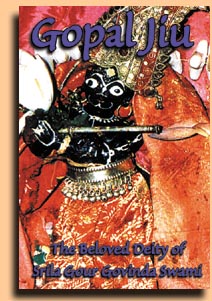
Then Gopal said, “You are worshipping here, but I can’t come here. Gadeigiri is the house of My devotees. They have no wealth, but their mind is always on Me. Even if they only offer Me a tulasi leaf and a little water I am happy there. They are always saying, ‘Gopal! Gopal!’ I cannot leave them and come here. You are not doing any service for Me because Ghanashyam has not given Me to you. He promised, ‘Unless Gopal tells me to give Him to Gour Govinda Swami I will not give Him.’” Gopal then said, “I will speak to Ghanashyam. First I have met with you and now I am going to Ghanashyam.”
While Gurudeva and I were speaking, one of my family members was there. They said, “You are always talking about donating Gopal, but you are only speaking and not giving.” I said, “No, today I must donate Gopal to Gurudeva. Bring tulasi and water and chant mantra.” Gurudeva asked, “How will you donate to me?”
I said, “As Srimad-Bhagavatam describes that Bali Maharaja donated to Lord Vamanadev, like that I will donate Gopal to you. You place your hand under mine and I will donate three times with water and tulasi leaf.”
I called for a brahmin who put tulasi and water in my hand. I said, “First I donate to you Sri Radha Gopalji. Secondly I give you all of Gopal’s paraphernalia. Thirdly I donate the property to you. From tomorrow you will take charge.
Gour Govinda Swami immediately accepted Gopal and the property, and on 15 November 1993 he recorded everything in the name of ISKCON, the institution of his spiritual master. Gour Govinda Swami then sent two disciples to Gadeigiri. They arranged to fix the broken temple building and made nice arrangements for Gopal’s worship. The existing temple for Gopal was very small and simple. Now that Gopal was under his care, Gour Govinda Maharaja wanted to build something nice for Gopal. He was very eager to see the work begin. On 23 November Fakir Charan went to see Gour Govinda Swami in Bhubaneswar. Fakir Charan remembers:
When he saw us he started scolding us. He said, “The registration was finished eight days ago, where have you been? My dear Gopal’s work is not going on correctly. Gopal is beating me.” He then showed us his back, which bore fresh marks from a beating. I was shocked. We both begged forgiveness for the delay. He then replied, “The devotee of Krishna never fears anyone. This is service for Krishna, so where is fear?
On 17 January 1994 Gour Govinda Swami laid the foundation stone for Gopal’s new temple and he installed a deity of Anantasesh. In his lecture that day he spoke to all of the devotees as well as to the laborers and construction workers who were there to begin work on the new temple:
With the help of the two rishis Bhrigu and Bharadwaj, Agastya Muni once built a huge temple for Krishna at Kalahasti in Rajasthan. Many laborers had been engaged to build that temple. Bhrigu and Bharadwaj were supervising them. The laborers were working hard from morning to sunset. Every evening before sunset, Agastya would sit on the bank of the nearby river and call all of the laborers. By his order, Bhrigu and Bharadwaj would then give a handful of sand to each laborer. That was their payment for the whole day’s work. But when the two rishis gave the sand, it at once turned into gold. According to how hard the laborer was working, he received a proportionate amount of gold. So whoever was working harder was getting more gold. Whoever was working less would only get a small amount, and if someone were not working at all, only cheating, they would find only sand in their hands, no gold. In this dealing there was no partiality and no complaints. Everything took place before God who is the supreme eyewitness. Each worker happily accepted his proper due, no more and no less. The laborers were thinking, “Whatever I am doing, Krishna is in my heart constantly watching me. So I am working in His presence.” If one has this kind of mentality his work is called sadhu-karma, very pious work. If your heart is clear then all your activities will be clear and pious. Whatever work you touch will be successful and great. This is Gopal’s work. Don’t neglect it. Don’t quarrel and don’t be duplicitous. Don’t steal anything. After this temple is complete, if the rules and regulations are followed nicely here, then it will help this area’s inhabitants in their spiritual as well as economic development.
Why are we building a temple here? Because this place is a tapa-bhumi, a place of austerities. This is a very special place. By doing only a little sadhana or bhajan here, one can get great benefit in his spiritual life. The kirtan and austerities of this place brought Gopal from Vrindavan. This place will kill the demoniac nature. Ravan was a most powerful demon, but he was always afraid of tapa-sakti, the power of austerities. Therefore he told his followers that they could go to every place to the north except for Vedapuri (now modern Pondicherry in South India), because that place would kill the demoniac nature. So this Gadeigiri, the place of Gopal, is a place of samskara and sadhana. Everyone should accept this place as their own and let their life be successful.
In late January 1996, Gour Govinda Swami mentioned, “Srila Bhaktisiddhanta said that this material world is not a fit place for any gentleman. Therefore, because he was disgusted, he left this world prematurely. I may also leave. I don’t know. Let me ask Gopal. I will do whatever He wants.” The next day he went to Gadeigiri to see Gopal. After returning, for the next four days he lectured before thousands of people at the Prabhupada Centennial festival in Bhubaneswar. Then he left for the annual ISKCON management meetings in Sridham Mayapur.
Ghanashyam recalls his discussion with Gour Govinda Swami during this last visit to Gadeigiri:
We were talking about Gopal’s new temple and installing large deities of Radha Gopal to go with the existing small ones. Suddenly Gurudeva told me, “I won’t see this deity installation. You will see it, but I won’t.”
I said, “How is that? You are ten years younger than I am. If you won’t see it how will I?”
Gurudeva said, “No, no. You will see the inauguration of the temple and the deity because you have served Gopal so nicely. Uncle [Gopinath Giri] died thirty years ago and you went through so much difficulty to take care of Gopal. You continued all of the festivals, sarat-rasa, vasanta-rasa, etc. That is why Gopal is kind to you. So you will see Gopal’s new temple.”
That was the last discussion I had with Gurudeva. After that he went to Bhubaneswar for a few days and then to Mayapur where he stayed forever.
In Mayapur on 9 February 1996, the holy appearance day of Srila Bhaktisiddhanta Saraswati Thakur, two senior ISKCON devotees requested an appointment in the early evening to see Gour Govinda Maharaja. They inquired, “Why did Chaitanya Mahaprabhu stay in Jagannath Puri?” He enthusiastically began to explain the confidential significance of Mahaprabhu’s pastimes in Puri. He described the pains of separation felt by Radha and Krishna when Krishna was away from Vrindavan. He gradually unfolded the pastime to the point where Radha and Krishna were finally united after Their long separation. He described how Krishna became so ecstatic upon seeing Radharani that He manifested a form with big round eyes and shrunken limbs, Lord Jagannath. At that time the devotees noticed that tears had come to his eyes and his voice had become choked up. Barely audibly, he said, “Then the eyes of Krishna fell upon the eyes of Radharani. Eye-to-eye union.” Unable to continue, he apologized with folded hands, “Please excuse me. I cannot speak.” He then gave his final instruction: “Kirtan! Kirtan!” The devotees present began to chant as he calmly lay back on his bed, breathing slowly and deeply. Upon his request a servant placed a picture of Gopalji in his hand. Then, gazing lovingly at that picture of his worshipable deity, Gour Govinda Swami said, “Gopal!” Then his eyes closed and he lost external consciousness.
One devotee quickly ran to bring a doctor. Kaviraj Dr. D. K. Brahma M.D. recalls:
Just before sandhya arati a devotee came to my residence and told me that Gour Govinda Swami was having some problem breathing and could I come to see him. When I arrived, Maharaja was lying down. Some doctors had come before me and had said that Maharaja had already passed away. Others were saying that we should take him to Krishnanagar and give him treatment in the Government hospital. I took his pulse and found that he was still alive.
I told them, “Just wait. Give me another twelve minutes time, then I may tell you to take him.”
If they would have taken him to the Government hospital it means they would have been pumping his chest, thinking it was a heart attack. However, according to his pulse there was nothing wrong with him. His pulse only showed that he was taking rest. The Ayurvedic science teaches how to diagnose a patient by taking his pulse. If something is wrong we can feel it. But I never found anything wrong with Maharaja. According to his pulse everything was normal.
By the second or third time I read Maharaja’s pulse it had become clear that he had left. Some say that he had a heart attack, but if someone dies from a heart attack generally we find that they suffer a lot. They also generally have some previous history of a weak heart. In Maharaja’s case, none of these things were there. Maharaja had the symptoms of asta-sattvika-vikara, ecstatic transformations, on his body. One kind of vikara is that one doesn’t want to stay here any longer, they want to go back to the spiritual abode, back to Krishna. Nothing in Maharaja’s body failed, he just left. I am 100% sure of that. I’ve never seen this kind of death before. * * *
Ghanashyam Giri: Gurudeva told me that Gopal is always anxious to hear nama. He came all the way from Vrindavan only to hear nama-sankirtan. He did not come to take food. He has no deficiency. He came here only for hearing nama. Gopal is namapriya-thakura, the Lord always eager to hear nama.
Gurudeva has fulfilled Gopal’s desire. Now I’m practically seeing that from morning to night, kirtan, bhajana, is always going on for Gopal. So many devotees are coming here from all over the world. I am feeling happy seeing how Gurudeva has fulfilled the desire of Gopal.
On 18 March 1991 Gour Govinda Swami brought some of his Western disciples to Gadeigiri and spoke a few words about Gopal:
From my boyhood this deity has occupied my heart. Everywhere I look I am seeing Him. Most of my childhood I spent here. I am 62 years old. Any day I may pass away, die. I have this desire that here in Gopal’s place something be built. That will make me happy.
Appendix One – The Giri Family
Interviews with members of the Giri family supplied us with ages at the time of death of the members of the Giri family from Gadai Giri up until the present day. As is common in rural Orissa, there is no recorded date for any of the births or deaths of the members of the Giri family up until the time of Bauri Giri. Thus the exact dates given in this chart for the time period from Gadai Giri up to Govinda Giri are approximate. Gadai Giri Established Gadeigiri in 1695 | Gopal Giri 1720 -1805 | Dinabandhu Giri 1745 -1830 | Abhiram Giri 1770 -1860 | Bhagavat Charan Giri 1795 -1877 | Bhikari Giri 1825-1908 | Govinda Giri 1845 -1933 | Bauri Giri 1870-1939
Appendix Two – Special Festivals
The following is a list of all the special festivals that take place in Gadeigiri. Some of these festivals are not normally observed elaborately in other ISKCON centers. For exact dates see the ISKCON calendar.
• Gaura Purnima
• Dola-yatra — A very popular festival in Orissa, Dola-yatra begins on Gaura Purnima day (also known as Dola Purnima) and continues for seven days. The deities are taken by palanquin to the homes of various local devotees. There, Sri Radha-Gopalji are offered special foodstuffs and kirtan. This festival is also observed for other local deities of Radha and Krishna. On the seventh day all of the deities come together for a grand festival in one place.
• Vasanta-rasa — A rasa arena is made in the temple courtyard and the deities are brought out. They listen to traditional Oriya lila-kirtan sung by local devotees. Celebrated on the full moon day at the end of the month of Vishnu (March-April).
• Chandan-yatra — For twenty-one days of the summer season, Radha-Gopal are smeared with sandalwood paste, then taken for a boat ride in the evening. This festival begins on the third day of the bright fortnight of the month of Madhusudana (April-May).
• Snana-yatra — Public bathing ceremony for Lord Jagannath on the full moon day of the month of Trivikrama (May-June).
• Janmastami
• Appearance day of Srila A.C. Bhaktivedanta Swami Prabhupada
• Appearance day of Srila Gour Govinda Swami — Celebrated on the first day of the bright fortnight of the month of Hrishikesh (August-September).
• Radhastami
• Sarat-rasa — Performed in the same manner as Vasanta-rasa. Celebrated on the full moon day at the end of the month of Kartikka (October-November)
• Vasanta-pancami — The first day of spring. A special festival is held on this day commemorating the opening of the temple for Sri Sri Radha Gopalji. Celebrated on the fifth day of the bright fortnight of the month of Madhava (January-February)
• Disappearance day of Srila Gour Govinda Swami — Celebrated on the fifth day of the dark fortnight of the month of Govinda (February-March)
Tourist Information: From Cuttack there is daily bus service directly to Baharana, which stops at Gadeigiri. More frequently there are buses to Machhgaon, Borikina, and Naharana, all of which stop at Balikuda, 3 km from Gadeigiri.
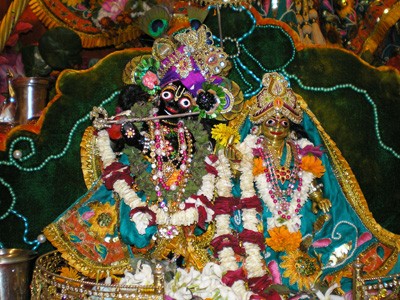
On different days
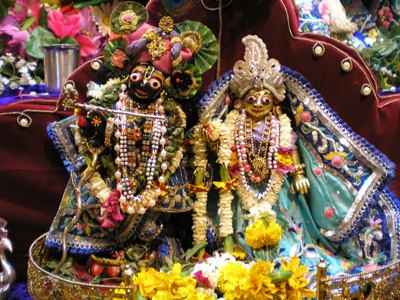

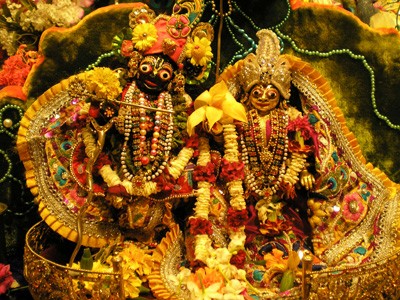
In different outfits
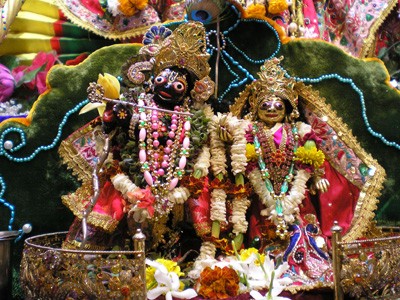
In Their nightoutfits under a different light
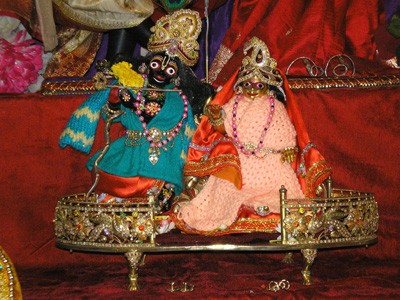
During the Vasanta rasa festival.
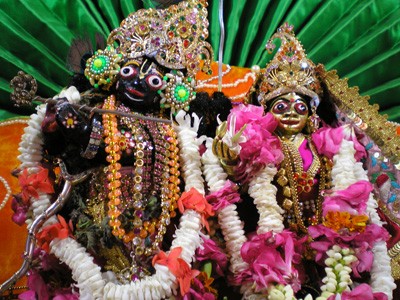
During the Dola yatra festival.
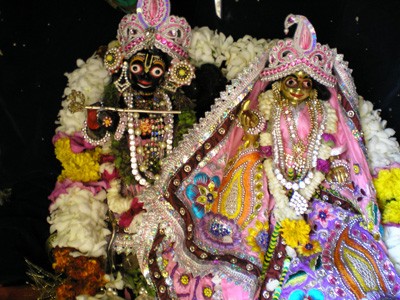
And during the Puspa abhiseka festival when Gopal, Sri Radhe and the other Persons on the altar are decorated with many flowers.
